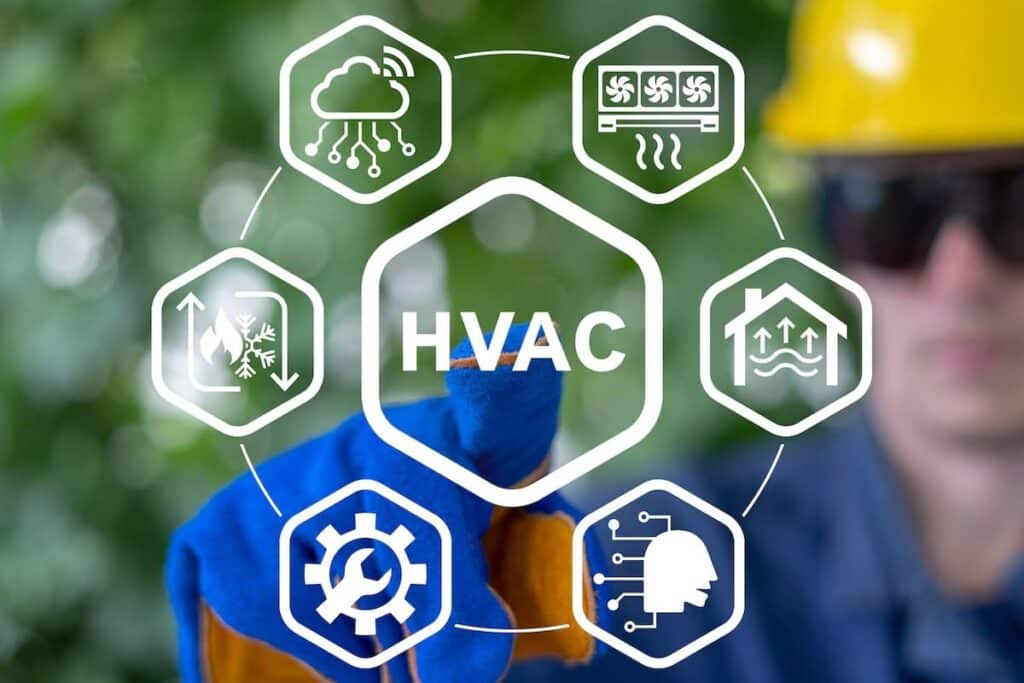HVAC System Basics
HVAC systems contain many important components, including the following:
Air Ducts
A building’s ductwork is a system of tubing that runs throughout the walls and ceiling to carry warm or cool air from a central HVAC unit to multiple parts of the building. Ducts should be sealed and insulated to provide the highest energy efficiency. Air ducts are attached to air conditioners and heating units using special ductwork pieces called plenums. There are usually two plenums in a system: the supply plenum that handles outflow and the return plenum that handles inflow.
Air Handlers
The air handler is the indoor portion of a central heating or cooling system that moves conditioned air throughout the building. It contains a blower motor and fan that sends heated or cooled air into the ductwork. The air handler also brings in air to be treated. In an AC unit, the air handler contains the evaporator coils that cool the air as it passes through.
Condensers
The condenser is the outdoor unit of a central AC system. It acts as a heat exchanger for the refrigerant, a chemical used in ACs that produces a cooling effect when it expands or vaporizes. The condenser contains condenser coils, which release heat from the refrigerant into the outside air, and the compressor, which prepares the refrigerant to return indoors and cool more air.
Humidifiers and Dehumidifiers
Depending on your local climate, the air in your home may need to be humidified or dehumidified to make your home comfortable and protect it from mold and mildew. Humidifiers add moisture to the air and dehumidifiers remove it. Air conditioning systems automatically dehumidify the air, but you’ll need to add a separate humidifier to your HVAC system in dry climates.
Refrigerant
Refrigerant is a liquid that’s used to transfer heat from one place to another. In an air conditioner, it pulls heat from the indoor air and transfers it outside, cooling the indoor environment. Freon is one brand of refrigerant, but it’s sometimes used to refer to all refrigerants the way that Kleenex stands in for all facial tissue brands.
Thermostat
Most HVAC systems have a device for regulating the system’s function called a thermostat. The user sets the thermostat to their desired temperature, and the HVAC system works until temperature is reached and then turns off. This helps conserve energy and maintain a consistently comfortable environment.
Vents
An HVAC system’s vents connect the ductwork to a building’s interior or exterior. Vents serve many purposes, such as ensuring airflow and bringing in fresh air.
Types of HVAC Systems
HVAC systems may provide heating, cooling, or both. Here are some of the most common systems you’ll find in homes today.
Air Conditioning
All air conditioners operate similarly: Blowing indoor air over tubes full of refrigerant to remove heat and humidity from the air. The heated refrigerant then travels to the outdoor part of the system, where it cools back down before returning indoors to start the process over. However, each system differs in how the components are packaged.
Central Air Conditioning
Central AC is a split system, requiring both an indoor air handler and an outdoor compressor. These are the most powerful and efficient types of air conditioners, but
central air conditioners cost the most to install and run. They also require ductwork, so installing central AC if your home wasn’t built for it is expensive. However, in hot climates, central air goes a long way in making an entire home comfortable.
Mini-Splits
Mini-split systems also require an outdoor condenser and one or more indoor air handlers, but they don’t need ductwork. Instead, homeowners install an air handler in each room they wish to cool. Mini splits are a great choice for cooling multiple rooms in an older house or one without existing ductwork. They’re also more customizable than central AC. Not everyone likes the look of an air handler unit mounted on the wall or ceiling, but there are
ways to conceal them.
Boilers
Boilers are somewhat uncommon HVAC equipment because they don’t blow forced air. Instead, boilers heat water, sometimes past its boiling point until it becomes steam, to send through a network of radiators throughout a building. The heated radiators then heat the air in each room. Boilers may run on natural gas including propane, heating oil, electricity, or even wood.
Furnaces
Furnaces burn fuel to warm air, which they then blow into a home’s ductwork for distribution throughout the house. Propane and natural gas furnaces are the most common and least expensive to operate, though some older homes in cold climates may still have furnaces that burn heating oil. These are powerful heaters, but they can produce toxic fumes such as carbon monoxide that must be properly vented.
Electric furnaces exist, but they take a lot of power and are slow to heat up, so they’re usually found in mild climates. Many mini-split systems can also act as electric furnaces.
Heat Pumps
A heat pump system transfers heat indoors in winter and outdoors in summer, providing both heating and cooling in one. These systems are highly efficient: An electric heat pump can heat your home with approximately
50% less electricity than a comparable furnace.
Packaged Systems
Packaged systems combine heating and cooling equipment in a single housing that’s located outdoors. A heat pump with extra evaporator coils for cooling is one type of packaged system, and an air conditioner with added heat strips is another. These systems save indoor space by putting all the equipment outdoors, but they typically aren’t as powerful or efficient as other systems. Thus, they’re mostly used in small homes.
Radiant Heating
Radiant heating systems directly heat your home’s walls or floor, warming it without needing to circulate air. Most of these systems, called hydronic systems, use hot water or steam from a boiler to produce heat, but others may use electric heat cables. Radiant heating uses energy efficiently and reduces the circulation of allergens, but it’s difficult to install, particularly if your home wasn’t originally designed for it.
What Is the Difference Between HVAC and Air Conditioning?
Air conditioning is a type of HVAC system. Essentially, all air conditioners are HVAC systems, but not all HVAC systems are air conditioners. HVAC stands for heating, ventilation, and air conditioning, so it encompasses heating and ventilation systems such as furnaces, boilers, and heat pumps as well. However, many people use “HVAC” and “air conditioner” interchangeably, leading to confusion.


